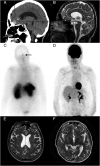Successful treatment of tumor-induced osteomalacia due to an intracranial tumor by fractionated stereotactic radiotherapy
- PMID: 24014621
- PMCID: PMC5399525
- DOI: 10.1210/jc.2013-2528
Successful treatment of tumor-induced osteomalacia due to an intracranial tumor by fractionated stereotactic radiotherapy
Abstract
Context: Tumor-induced osteomalacia (TIO) is a rare paraneoplastic syndrome, characterized by tumor secretion of fibroblast growth factor-23 (FGF23) causing hypophosphatemia due to renal phosphate wasting. TIO is usually caused by small, benign, difficult-to-localize, mesenchymal tumors. Although surgery with wide excision of tumor borders is considered the "gold standard" for definitive therapy, it can be associated with considerable morbidity depending on the location. To date, radiation therapy has not been considered as an effective treatment modality in TIO.
Objective: A 67-year-old female presented with multiple nontraumatic fractures, progressive bone pain, and muscle weakness for 4 years. She was found to have biochemical evidence of urinary phosphate wasting with low serum phosphorus, low-normal serum calcium, normal 25-hydroxyvitamin D and 1,25-dihydroxyvitamin D, and high serum FGF23 levels. TIO was diagnosed. Selective venous sampling for FGF23 confirmed that a 1.7-cm left frontal mass, radiographically similar to a meningioma, was the causative tumor. She declined surgery due to fear of complications and instead underwent fractionated stereotactic radiotherapy for 6 weeks.
Results: In less than 4 years after radiation therapy, she was successfully weaned off phosphorus and calcitriol, starting from 2 g of oral phosphorus daily and 1 μg of calcitriol daily. Her symptoms have resolved, and she has not had any new fractures.
Conclusions: Stereotactic radiotherapy was an effective treatment modality for TIO in our patient. Fractionated stereotactic radiation therapy represents an alternative to surgery for patients with TIO who are not surgical candidates or who decline surgery.
Figures


References
-
- Shimada T, Hasegawa H, Yamazaki Y, et al. . FGF-23 is a potent regulator of vitamin D metabolism and phosphate homeostasis. J Bone Miner Res. 2004;19:429–435. - PubMed
-
- Harvey JN, Gray C, Belchetz PE. Oncogenous osteomalacia and malignancy. Clin Endocrinol (Oxf). 1992;37:379–382. - PubMed
-
- Uramoto N, Furukawa M, Yoshizaki T. Malignant phosphaturic mesenchymal tumor, mixed connective tissue variant of the tongue. Auris Nasus Larynx. 2009;36:104–105. - PubMed
Publication types
MeSH terms
Grants and funding
LinkOut - more resources
Full Text Sources
Other Literature Sources

